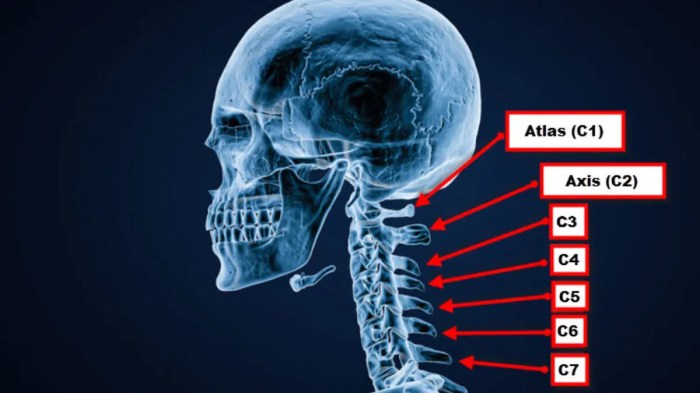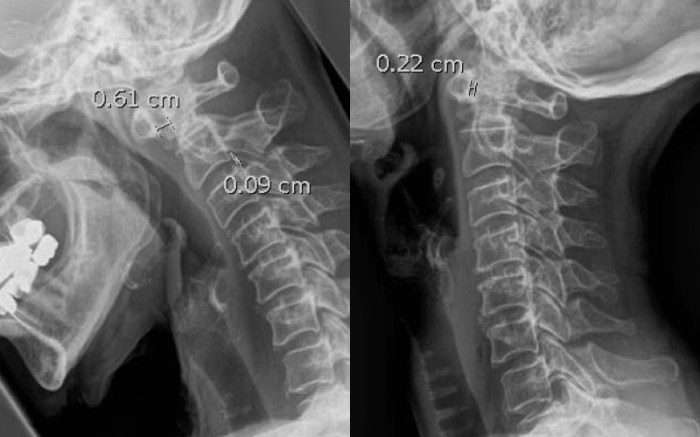Neck arthritis exercises to avoid are crucial for preventing further pain and discomfort. Understanding which movements could exacerbate your condition is key to maintaining a healthy neck. This guide explores common exercises that should be modified or avoided altogether, offering practical advice for individuals with neck arthritis.
This comprehensive guide will cover various aspects, including the anatomy of the neck, common causes and symptoms of neck arthritis, and potential exercise risks. We’ll delve into specific exercises to avoid, offering alternatives and discussing the importance of professional guidance. The goal is to empower you with the knowledge to make informed decisions about your neck health.
Introduction to Neck Arthritis
Neck arthritis, also known as cervical arthritis, is a condition characterized by inflammation and degeneration of the joints in the neck. This inflammation can affect the cartilage, ligaments, and surrounding tissues, leading to pain, stiffness, and reduced mobility. Common types include osteoarthritis, rheumatoid arthritis, and psoriatic arthritis, each with varying causes and symptoms. Osteoarthritis, the most prevalent form, typically develops due to age-related wear and tear, while rheumatoid arthritis is an autoimmune disease.
Psoriatic arthritis is linked to psoriasis, a skin condition. Understanding these differences is crucial for appropriate treatment and exercise plans.The impact of neck arthritis extends beyond just pain. It can lead to restricted movement, impacting daily activities like turning your head, looking up or down, and even swallowing. Severe cases can compress nerves and blood vessels, potentially causing further complications.
Consequently, managing neck arthritis effectively requires a multi-faceted approach, incorporating medication, physical therapy, and lifestyle modifications, including carefully designed exercises. A crucial aspect of this management is understanding the specific contraindications for exercise, to prevent exacerbating the condition.
Understanding Potential Exercise Contraindications
Exercise is often a vital component of managing neck arthritis, but it’s crucial to understand potential contraindications. Certain movements or intensities can aggravate the inflammation and pain, potentially leading to further damage to the already compromised joints. This necessitates a cautious and individualized approach to exercise, focusing on gentle, controlled movements that enhance range of motion and build strength without causing further strain.
Types of Neck Arthritis
A comprehensive understanding of the different types of neck arthritis is essential for tailoring appropriate treatment strategies. Each type presents with its unique set of symptoms, causes, and potential complications.
| Condition | Symptoms | Potential Causes | General Treatment Approaches |
|---|---|---|---|
| Osteoarthritis | Pain, stiffness, creaking or grinding sounds in the neck, reduced range of motion, and potential numbness or tingling in the arms. | Age-related wear and tear of the cartilage, genetics, and repetitive strain. | Pain relievers, physical therapy (including exercises to strengthen supporting muscles), and assistive devices. |
| Rheumatoid Arthritis | Pain, stiffness, swelling, and tenderness in the neck joints, fatigue, and potential systemic symptoms. | An autoimmune response that attacks the body’s own tissues, potentially genetic predisposition. | Disease-modifying antirheumatic drugs (DMARDs), pain relievers, physical therapy (focused on maintaining range of motion and preventing joint deformities). |
| Psoriatic Arthritis | Pain, stiffness, swelling, and inflammation in the neck joints, often accompanied by skin lesions associated with psoriasis. | Linked to psoriasis, an autoimmune skin condition. | Combination therapy that targets both the skin condition and the joint inflammation, often including DMARDs, topical treatments, and physical therapy. |
Identifying Exercises to Avoid
Neck arthritis can be a debilitating condition, significantly impacting daily activities. Understanding which exercises to avoid is crucial for managing symptoms and preventing further damage. This section will highlight common neck exercises that could exacerbate the condition, enabling you to tailor your routine to your specific needs.
Avoiding certain neck exercises is crucial for those with arthritis. For instance, stretches that involve forceful twisting or jerky movements should be avoided. Finding ways to improve flexibility, like the ones discussed in how to become more flexible , can actually help you avoid exacerbating neck pain. Gentle, controlled movements are key to managing arthritis symptoms and preventing further injury in the neck area.
Common Problematic Neck Exercises
Certain neck stretches and movements can put undue stress on the already compromised joints and tissues of the neck. Understanding these movements and their potential risks is essential for creating a safe and effective exercise program.
Exercises to Avoid
A range of exercises, while seemingly innocuous, can aggravate neck arthritis. These include forceful, jerky movements, rapid rotations, and stretches that pull or extend the neck beyond its comfortable range of motion. Exercises that cause pain or discomfort should be avoided immediately.
Examples of Risky Exercises
Examples of exercises that might exacerbate neck arthritis include aggressive neck rotations, lateral bending past a comfortable point, and hyperextension stretches. Over-exertion or repetitive motions in these ranges can put stress on the affected joints, leading to further pain and inflammation.
When dealing with neck arthritis, certain exercises are best avoided. For instance, intense stretches or movements that force the neck into awkward positions can exacerbate the condition. Understanding your sleeping posture might offer clues to why your neck is feeling the strain. Consider reading up on what your sleeping position says about you what your sleeping position says about you and if your current position might be contributing to your neck pain.
Ultimately, choosing exercises that gently strengthen and support the neck is key to preventing further arthritis issues.
Table: Common Exercises and Potential Impact
| Exercise Type | Description | Potential Risks | Alternatives |
|---|---|---|---|
| Aggressive Neck Rotations | Rotating the head rapidly or forcefully from side to side. | Can strain the neck muscles and ligaments, potentially damaging the already compromised cervical joints. | Gentle, controlled neck rotations within a pain-free range of motion, or alternative exercises that focus on other muscle groups. |
| Excessive Lateral Bending | Bending the neck from side to side, exceeding a comfortable range of motion. | Places stress on the facet joints and surrounding tissues, potentially increasing pain and inflammation. | Gentle side-bending exercises within a pain-free range, or exercises that focus on strengthening the neck muscles. |
| Hyperextension Stretches | Extending the neck backward, pushing it beyond its natural range. | Can strain the posterior neck muscles and ligaments, leading to increased pain and potential joint damage. | Gentle neck stretches focusing on a pain-free range, or exercises that strengthen the neck muscles without hyperextension. |
| Jerky or Sudden Movements | Performing neck exercises with quick, jerky motions. | Can cause sudden jolts to the neck, leading to increased pain and inflammation in the cervical spine. | Slow, controlled movements that maintain a consistent range of motion, or focusing on exercises that strengthen and stabilize the neck muscles. |
| Repetitive Stress Exercises | Performing the same neck movement repeatedly without proper rest or recovery. | Can cause micro-tears in the neck muscles and ligaments, leading to persistent pain and stiffness. | Modifying the exercise to reduce repetition, incorporating rest periods between sets, or performing alternative exercises. |
Understanding the Mechanics of Neck Pain
Neck pain, a common ailment, can stem from a complex interplay of anatomical structures and biomechanical factors. Understanding these intricacies is crucial for identifying potential triggers and developing appropriate strategies to manage and prevent further injury. This knowledge allows individuals to tailor their activities and exercises to support a healthy neck, avoiding exacerbations of existing conditions or the development of new ones.The neck, a highly mobile segment of the spine, is composed of several interconnected structures.
These include vertebrae, intervertebral discs, facet joints, muscles, ligaments, and nerves. The delicate balance between these components allows for a wide range of movements, but also makes the neck vulnerable to injury. Poor posture, repetitive movements, and sudden impacts can all contribute to neck pain.
Anatomical Structures Involved in Neck Pain
The cervical spine is a complex network of interconnected elements. Vertebrae form the structural framework, cushioned by intervertebral discs that act as shock absorbers. Facet joints, located between the vertebrae, facilitate gliding movements. Muscles, including the deep neck flexors and extensors, support the spine and allow for controlled movements. Ligaments provide stability, preventing excessive movement.
Nerves exiting the spinal cord traverse the neck, and any impingement on these nerves can lead to pain and other symptoms.
Biomechanics of the Neck and Pain
The biomechanics of the neck dictate how movements affect its stability and vulnerability to injury. Excessive flexion, extension, rotation, or lateral bending can strain or irritate these components. Poor posture, for instance, can lead to sustained stress on specific structures, increasing the risk of long-term issues. Rapid movements, especially those involving twisting or jerking, are particularly prone to causing acute pain.
Role of Inflammation and Degeneration in Neck Arthritis
In neck arthritis, inflammation and degeneration of the cartilage and surrounding tissues play a significant role. The cartilage that cushions the facet joints can break down, leading to friction and pain. Inflammation can further exacerbate these issues, increasing the discomfort and restricting movement. These degenerative processes can also affect the ligaments and muscles, creating a cascade of pain and stiffness.
Exercises need to be carefully chosen to avoid further damage to already compromised structures.
Prevention Strategies for Neck Pain
A proactive approach to preventing neck pain involves understanding the potential injuries associated with various movements. A thorough knowledge of the structures and their functions helps individuals choose activities that minimize the risk of injury.
| Structure | Function | Potential Injury | Prevention Strategies |
|---|---|---|---|
| Vertebrae | Support and structure of the neck | Fracture, compression | Maintain good posture, avoid sudden movements, use proper lifting techniques. |
| Intervertebral Discs | Shock absorption, flexibility | Herniation, bulge | Maintain good posture, avoid prolonged periods of static positions, practice core strengthening exercises. |
| Facet Joints | Allow for gliding movements | Inflammation, arthritis | Avoid excessive twisting, maintain proper alignment, use ergonomic tools for repetitive tasks. |
| Muscles | Support and movement of the neck | Strain, spasm | Strengthen the deep neck flexors, avoid holding the head in one position for extended periods, use proper form during exercise. |
| Ligaments | Stability and support | Sprain, tear | Gradually increase the range of motion, avoid sudden movements, stretch regularly. |
Specific Exercise Precautions
Protecting your neck during exercise is crucial when you have arthritis. Certain movements can exacerbate pain and inflammation, potentially leading to further damage. Understanding which exercises to avoid and how to modify others is key to maintaining a healthy neck.
Avoiding Extreme Rotations
Excessive twisting of the neck can put undue stress on the already compromised joints and ligaments. This can irritate the affected tissues and potentially lead to more severe pain. It’s essential to avoid movements that cause discomfort or pain during the rotation. Instead, focus on exercises that promote controlled and gentle neck stretches.
Preventing Hyperextensions
Hyperextensions, or excessive backward bending of the neck, should be strictly avoided. This type of movement places significant strain on the cervical spine, particularly the facet joints. If you experience neck pain with hyperextensions, you should modify the exercise or discontinue it entirely. A hyperextension can cause a sudden, sharp pain that can radiate to the shoulders or head.
Minimizing Forceful Flexions
Forceful flexion, or bending the neck too far forward, can also cause problems. Sudden or forceful movements can exacerbate inflammation and strain supporting muscles and ligaments. Instead of focusing on how far you can bend, concentrate on maintaining a controlled range of motion and listening to your body. Sustained forward flexion can also put undue stress on the spine.
Importance of Proper Posture
Maintaining good posture during any activity, including exercises, is paramount. Poor posture can put extra strain on the neck, potentially worsening arthritis symptoms. Proper alignment involves keeping your head centered over your shoulders and your spine straight. Maintaining this alignment during activities, even daily ones, can make a significant difference in neck pain management.
Examples of Exercises to Modify or Avoid
Some exercises that may need modification or complete avoidance for individuals with neck arthritis include:
- Neck circles: These exercises often involve excessive rotations and hyperextensions, which should be avoided or modified by reducing the radius of the circle and the range of motion.
- Neck stretches with resistance bands or weights: If the resistance is too high, these can put undue strain on the neck, potentially leading to injury. Start with very light resistance and gradually increase it as your neck strengthens and tolerance improves.
- Sudden, jerky movements: Any movement that involves abrupt or forceful changes in position, especially in the neck, should be avoided. These movements are likely to cause inflammation and further pain.
Modified Exercise Table
This table Artikels common neck exercises and provides modifications for individuals with neck arthritis. It’s essential to consult with a healthcare professional before starting any new exercise regimen.
Avoiding certain neck arthritis exercises is crucial, especially if you have a sensitivity to germs, like in the case of mysophobia, a phobia of germs. This phobia can make you anxious about potentially contaminated equipment or tools. So, it’s essential to choose exercises that minimize this risk and maintain good hygiene, like using clean mats and equipment for neck stretches and avoiding crowded exercise spaces.
Proper precautions will help you stay focused on your recovery and avoid unnecessary discomfort.
| Exercise | Description | Modification for Arthritis | Precautions |
|---|---|---|---|
| Neck Flexion | Gentle bending of the neck forward | Maintain a slow, controlled motion, avoid sudden movements. Use a resistance band if necessary but keep the resistance light. | Do not push beyond a comfortable range of motion. Stop if pain occurs. |
| Neck Extension | Gentle bending of the neck backward | Maintain a slow, controlled motion. Limit the range of motion to avoid hyperextension. | Avoid any jerky or sudden movements. |
| Neck Rotation | Rotating the head from side to side | Maintain a slow, controlled motion. Keep the rotation limited to a comfortable range. | Avoid forceful or rapid rotations. |
| Neck Side Bending | Bending the head to the sides | Maintain a slow, controlled motion. Limit the range of motion to avoid straining the neck muscles. | Avoid excessive or jerky movements. |
Alternative Exercises and Treatments
Beyond avoiding certain exercises, a comprehensive approach to neck arthritis management involves exploring alternative strategies for strengthening neck muscles and alleviating pain. This includes a range of exercises, therapies, and lifestyle adjustments, each with its own set of benefits and limitations. A personalized approach, guided by a healthcare professional, is crucial for optimal results.Effective management of neck arthritis often requires a multifaceted strategy, blending exercise modifications with complementary therapies.
Understanding the specific benefits and drawbacks of various approaches allows individuals to make informed decisions regarding their treatment plans.
Strengthening Exercises for the Neck
Strengthening neck muscles without exacerbating pain is key to maintaining stability and reducing discomfort. Gentle, progressive exercises, focusing on controlled movements, are vital. These exercises should be performed with proper form and gradually increased in intensity. Examples include isometric exercises, where muscles are contracted without significant movement, and exercises that involve controlled range-of-motion movements.
- Isometric exercises: These involve contracting neck muscles against resistance without significant movement. Examples include gently pressing your head against a wall or resistance band, holding for a few seconds, and repeating several times. Isometric exercises are generally considered safe and effective for building neck strength without putting excessive strain on the joints.
- Gentle range-of-motion exercises: These exercises focus on gradually increasing the movement of the neck in different directions. For example, slowly tilting your head to the left and right, forward and backward, and rotating your head in a circular motion. It is crucial to maintain a slow and controlled tempo to avoid stressing the neck.
- Neck stretches: Gentle stretches can help alleviate stiffness and improve flexibility. Examples include stretching the front of the neck by gently pulling your chin toward your chest and holding for a few seconds, and stretching the back of the neck by gently tilting your head back. These should be performed slowly and without pushing beyond a comfortable range.
Alternative Treatment Approaches
Beyond exercise, various treatment options can help manage neck arthritis symptoms. These options, when used in conjunction with exercise modifications, can provide comprehensive relief.
- Medications: Over-the-counter pain relievers, such as ibuprofen or naproxen, can help reduce inflammation and pain. Prescription medications, like certain muscle relaxants or corticosteroids, might be necessary in more severe cases. These medications can be helpful but may have side effects.
- Physical therapy: A physical therapist can provide tailored exercises, manual therapy techniques, and advice on posture and lifestyle changes. Specific exercises and techniques can be beneficial in strengthening supporting muscles and improving range of motion. Physical therapy is a crucial aspect of management, often offering a structured approach to recovery and long-term well-being.
- Lifestyle modifications: Maintaining a healthy weight, avoiding prolonged periods of inactivity, and adopting good posture habits are important lifestyle factors. Proper posture helps distribute weight evenly, reducing strain on the neck. Regular breaks from work or other activities that involve prolonged sitting or straining the neck can significantly reduce pain and discomfort.
Comparison of Neck Arthritis Treatments
| Treatment Type | Description | Benefits | Limitations |
|---|---|---|---|
| Exercise Modifications | Tailored exercises focusing on controlled movements and strengthening without causing pain. | Improved neck strength, reduced pain, enhanced range of motion. | Requires patience and consistent practice. Incorrect form can worsen symptoms. |
| Physical Therapy | Personalized exercises, manual therapy, and lifestyle advice. | Targeted treatment for specific needs, professional guidance, long-term management strategies. | May require multiple sessions. Cost can be a factor. |
| Medications | Over-the-counter or prescription pain relievers, muscle relaxants, or corticosteroids. | Quick relief from pain and inflammation. | Potential side effects, may not address underlying issues, long-term use may be problematic. |
Importance of Professional Guidance: Neck Arthritis Exercises To Avoid

Taking care of neck arthritis requires a cautious approach, and one crucial aspect is seeking professional guidance. Simply finding exercises online or from friends might not be the best strategy. A personalized plan, tailored to your specific condition and limitations, is essential for preventing further injury and promoting healing.Professional guidance is paramount because neck arthritis presents a complex interplay of pain, stiffness, and potential underlying conditions.
A healthcare professional can accurately assess your specific needs, identify potential risks, and create a safe and effective exercise program. This personalized approach maximizes the benefits and minimizes the risks associated with exercise.
Crucial Role of Healthcare Professionals, Neck arthritis exercises to avoid
Healthcare professionals, including physical therapists and physicians, play a vital role in developing safe and effective exercise programs for neck arthritis. They possess the expertise to evaluate your condition, understand your limitations, and design exercises that target specific areas of weakness or pain while avoiding harmful movements. Physical therapists are trained in manual therapy, exercise prescription, and patient education, making them well-suited to guide you through your recovery journey.
Doctors can assess your overall health, rule out other potential causes of neck pain, and ensure the exercises are compatible with any other medical conditions you may have.
Questions to Ask a Doctor or Physical Therapist
It’s essential to ask the right questions to ensure you receive the best possible care. These questions can help you understand your condition and the exercises prescribed. Example questions to ask include: “What are the specific exercises recommended for my type of neck arthritis?”, “What are the potential risks associated with these exercises?”, “What are the expected outcomes and timelines for improvement?”, and “What modifications should I make if I experience pain or discomfort during the exercises?”.
Steps to Take Before Starting an Exercise Program
Understanding the process before embarking on an exercise program is critical. This structured approach helps ensure safety and effectiveness. The table below Artikels the key steps and their importance in managing neck arthritis.
| Step | Action | Importance |
|---|---|---|
| 1 | Consult a Healthcare Professional | Crucial for proper diagnosis, personalized exercise prescription, and risk assessment. |
| 2 | Thorough Evaluation | Allows the professional to identify specific needs, limitations, and potential complications. |
| 3 | Understand Exercise Instructions | Ensures correct form and technique to prevent injury and maximize benefits. |
| 4 | Gradual Progression | Avoids overexertion and allows the body to adapt to the exercises. |
| 5 | Regular Monitoring and Adjustment | Enables the professional to assess progress, identify any emerging issues, and modify the program as needed. |
Illustrative Examples of Exercises to Avoid
Neck arthritis can be aggravated by certain exercises if not performed correctly. Understanding which movements to avoid is crucial for preventing further pain and discomfort. Choosing appropriate alternatives is equally important for maintaining neck health and promoting healing.Identifying exercises that strain the neck is key to protecting your joints. Many seemingly harmless movements can become problematic when the spine is already compromised.
This section will present examples of exercises to avoid and illustrate safe alternatives, helping you make informed choices.
Specific Exercises to Avoid
Many exercises, while seemingly beneficial for overall fitness, can exacerbate neck arthritis symptoms if not performed with extreme caution. Certain movements can put undue stress on the already vulnerable cervical spine, leading to increased pain and inflammation. Understanding these movements is crucial to protecting your neck.
- Neck Rotations: Full-range neck rotations can place excessive strain on the delicate joints of the neck. Repeated rotation can irritate the inflamed areas and lead to increased pain and stiffness. The repetitive motion can contribute to further degeneration and potentially cause instability.
- Sudden Jerky Movements: Rapid or jerky head movements, even when seemingly insignificant, can cause sudden stress and impact on the neck, particularly when the neck is already prone to inflammation. These movements can quickly lead to acute pain episodes. Examples include sudden turns of the head or quick, forceful shrugs.
- Heavy Weight Lifting with Unsupported Neck: Lifting heavy weights without proper support, particularly when the head is held in a vulnerable position, can place a significant load on the neck. This can exacerbate existing arthritis pain and even potentially lead to herniated discs.
- High-Impact Exercises with Neck Strain: Exercises that involve a high degree of impact, such as high-impact aerobics or sports where the head is frequently in motion, can cause undue stress on the neck. If not performed cautiously, these can lead to further inflammation and pain. The high impact can lead to micro-trauma in the cervical spine, which can be significant in the context of existing arthritis.
Illustrative Examples of Proper and Incorrect Form
Understanding the correct and incorrect form of exercises is crucial in preventing further damage to the neck. This section will illustrate the differences between safe and harmful movements.
| Exercise | Correct Form | Incorrect Form | Description |
|---|---|---|---|
| Neck Flexion | Gentle, controlled bending of the head towards the chest, keeping the spine straight. | Rapid, jerky bending of the head towards the chest, rounding the shoulders. | Incorrect form places excessive strain on the cervical spine, increasing the risk of pain and further damage. Correct form keeps the spine aligned and minimizes stress on the neck. |
| Neck Extension | Gentle, controlled tilting of the head back, maintaining a straight posture. | Jerky tilting of the head back, arching the back. | Incorrect form overextends the cervical spine, causing strain and potential injury. Correct form keeps the neck aligned, protecting the delicate joints. |
| Neck Side Bending | Slow, controlled side-to-side movement of the head, maintaining a straight posture. | Rapid, jerky side bending of the head, tilting the head to one side. | Incorrect form puts excessive pressure on the neck’s side joints, causing strain and potential inflammation. Correct form keeps the spine straight and the neck aligned. |
| Neck Rotation | Slow, controlled rotation of the head, keeping the spine straight. | Rapid, forceful rotation of the head, twisting the neck. | Incorrect form places stress on the neck’s rotation joints, potentially leading to further inflammation. Correct form maintains spine alignment and minimizes stress on the neck. |
Final Wrap-Up

In conclusion, avoiding certain neck exercises is vital for managing neck arthritis effectively. By understanding the mechanics of neck pain, identifying problematic exercises, and exploring alternative treatments, you can actively participate in your recovery. Remember, consulting with a healthcare professional is paramount before starting any exercise program. This guide provides a starting point, but personalized advice from a doctor or physical therapist is essential for optimal results.









